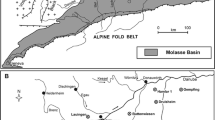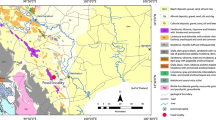Abstract
The biodiversity of Eocene Cerithioidean gastropods from a subtropical marine littoral environment, including mangroves with Nypa palms, is documented from the Figols Group (FG) and the overlying Castigaleu Group (CG) of the Ager and the Tremp–Graus basins (south–central Pyrenees, Spain). The stratigraphic interval includes the middle and upper Ypresian, encompassing the early Eocene climatic optimum (EECO). The malacofauna comprises a rich association of possibly intertidal species, dominated by Potamididae, Batillariidae, Pachychilidae, and Cerithiidae, with subordinate Melanopsidae, Thiaridae, Diastomidae, and Pachymelaniidae. The subtidal fauna is dominated by Turritellidae. The Cerithioidea fossil distribution is interpreted according to their local palaeoenvironmental gradients and through their genus-level stratigraphic distributions and according to known molecular phylogeny, ecology, and geographical range of Recent forms. The Cerithioidean record during the Palaeogene is revised on a global scale to obtain insights into the evolution across the EECO of some of the most widespread intertidal tropical organisms. The results suggest that Potamididae were adapted to mangrove trees since their first important diversification in Western Tethys and that some early Eocene genera survive in Recent mangrove-fringed coasts. In addition, the Batillariidae are very abundant and widespread in intertidal assemblages, undergoing rapid early Eocene turnovers, but within genera unrelated to modern forms. EECO Pachychilidae lived in brackish water habitats, contrary to purely freshwater Recent species. Turritellidae display an environmental distribution in the early Eocene similar to their modern distribution.
Access provided by Autonomous University of Puebla. Download conference paper PDF
Similar content being viewed by others
Keywords
Cerithioidean gastropods have been common elements of intertidal and subtidal marine ecosystems throughout the Cenozoic and are known for their sometimes-exceptional abundance in both ancient and modern shell beds. Their value as palaeoenvironmental indicators has been frequently stressed, with low-diversity, potamidid-dominated assemblages indicating mangrove forests and other euryhaline tropical to warm-temperate settings (Dominici and Kowalke 2007; Reid et al. 2008), batillariids indicating estuarine mudflats (Ozawa et al. 2009), cerithiids being particularly diverse in shallow subtidal bottoms (Houbrick 1993), and turritellids thriving at all shelf depths, often in monospecific “Turritella-beds” diagnostic of nutrient-rich waters (Allmon 1988). Modern molecular studies have shed light on phylogenetic relationships within the superfamily (Strong et al. 2011), consistent with the hypothesis of a Palaeogene evolutionary radiation in tropical waters (Reid et al. 2008; Ozawa et al. 2009). Details of the diversification and exact timings with respect to climatic events such as the PETM, EECO, and MECO are, however, still poorly understood, the fossil record remaining the only means for unravelling Cerithioidean history.
In this context, intertidal and subtidal lower Eocene shell beds of the Tremp–Graus and Ager basins, in the south–central Spanish Pyrenees, have been sampled and studied for the distribution of abundances within a high-resolution sequence-stratigraphic framework (Dominici and Kowalke 2007). Biotic gradients for the middle and upper parts of the Ypresian are compared with the Cenozoic record of some of the main Cerithioidean families. We found evidence of the primitive character of some modern clades and convincing evidence that a marked diversification of Cerithioidea took place during the EECO, starting from Palaeocene stem-groups. Eocene distribution in brackish water and marine environments is comparable with the modern distribution. However, freshwater families such as the Pachychilidae are more difficult to study, due to their rarity and out-of-habitat transportation. The fossil record of the Cerithioidean diversification coincides with the record of mangrove radiation, and is particularly pronounced in those intertidal families that in Recent settings show strict dependence to mangrove forests (Potamididae), or a distribution overlapping with mangrove habitats (Batillariidae). At a finer scale, palaeoenvironmental and biotic gradient analyses of Cerithioidea from the Spanish Pyrenees suggest that the distribution of early Eocene genera was parallel with modern distributions. Most Recent, strictly mangrove genera of tropical provinces, such as Terebralia, Cerithidea, Cerithideopsis, and Tympanotonos, were already present during the late Ypresian in the Western Tethys. The rarity of the first three genera and the abundance of the fourth in intertidal assemblages are consistent with a hypothesis of parallel faunal–floral distributions, with Terebralia, Cerithidea, and Cerithideopsis possibly being connected to the Lythraceae, Rhizophoraceae, and Pellicieraceae mangroves that had just appeared in the early Eocene (Ellison et al. 1999; Ricklefs et al. 2006), whereas Tympanotonos may have already been adapted to Nypa forests and therefore widespread since the Late Cretaceous, during the EECO reaching latitudes that are now under temperate conditions. In contrast, early Eocene Batillariidae genera Vicinocerithium and Granulolabium, where were also abundant and diverse during the EECO in intertidal habitats, are now extinct. Strict biotic interactions with mangrove trees may have played a positive role on Potamididae clade duration with respect to the Batillariidae.
The Pachychilidae are fairly well represented among intertidal and shallow subtidal assemblages. The studied genera are now extinct and probably constituted a sister group of Recent Pachychilidae, tropical gastropods that have instead diversified in freshwater habitats. The rarity in Pyrenean collections of strictly freshwater species of the Melanopsidae, Thiaridae, and Pachymelaniidae confirms that the fossil record can barely resolve the history of freshwater clades. Subtidal Cerithioidea were dominated by the Turritellidae, represented by species of Haustator, Sigmesalia, and Zaria. At present, Haustator lives in shallow tropical seas, whereas the other two are extinct. Patterns of Turritellidae diversity do not coincide with those of intertidal Cerithioidea, and the number of turritelline species decreased from the early Palaeocene to the early Eocene, with EECO species being eurytopic and persistent (Dominici and Kowalke 2007). As a whole, the large amount of data amassed on both fossil and modern Cerithioidea makes it a promising group for testing the relative role of biotic interactions in macroevolution. In particular, the adaptation of the Potamididae to mangrove forests, as here presented, appears to be a strictly synapomorphic character.
References
Allmon, W. D. (1988). Ecology of Recent turritelline gastropods (Prosobranchia, Turritellidae): Current knowledge and paleontological implications. Palaios,3, 259–284.
Dominici, S., & Kowalke, T. (2007). Depositional dynamics and the record of ecosystem stability: Early Eocene coastal communities in the Pyrenean foreland, Spain. Palaios,22, 268–284.
Ellison, A. M., Farnsworth, E. J., & Merkt, R. E. (1999). Origins of mangrove ecosystems and the mangrove biodiversity anomaly. Global Ecology and Biogeography,8, 95–115.
Houbrick, R. S. (1993). Phylogenetic relationships and generic review of the Bittiinae (Prosobranchia: Cerithioidea). Malacologia,35, 261–313.
Ozawa, T., Köhler, F., Reid, D. G., & Glaubrecht, M. (2009). Tethyan relicts on continental coastlines of the northwestern Pacific Ocean and Australasia: Molecular phylogeny and fossil record of batillariid gastropods (Caenogastropoda, Cerithioidea). Zoologica Scripta,38, 503–525.
Reid, D. G., Dyal, P., Lozouet, P., Glaubrecht, M., & Williams, S. T. (2008). Mudwhelks and mangroves: The evolutionary history of an ecological association (Gastropoda: Potamididae). Molecular Phylogenetics and Evolution,47, 680–699.
Ricklefs, R. E., Schwarzbach, A. E., & Renner, S. S. (2006). Rate of Lineage Origin Explains the Diversity Anomaly in the World’s Mangrove Vegetation. American Naturalist,168, 805–810.
Strong, E.E., Colgan, D.J., Healy, J.M., Lydeard, C., Ponder, W.F., & Glaubrecht, M. (2011). Phylogeny of the gastropod superfamily Cerithioidea using morphology and molecules. Zoological Journal Linnean Society 162, 43–89.
Author information
Authors and Affiliations
Corresponding author
Editor information
Editors and Affiliations
Rights and permissions
Copyright information
© 2014 Springer-Verlag Berlin Heidelberg
About this paper
Cite this paper
Dominici, S., Kowalke, T. (2014). Early Eocene Cerithioidean Gastropods from a Subtropical Coast Environment (South–Central Pyrenees, Spain). In: Rocha, R., Pais, J., Kullberg, J., Finney, S. (eds) STRATI 2013. Springer Geology. Springer, Cham. https://doi.org/10.1007/978-3-319-04364-7_17
Download citation
DOI: https://doi.org/10.1007/978-3-319-04364-7_17
Published:
Publisher Name: Springer, Cham
Print ISBN: 978-3-319-04363-0
Online ISBN: 978-3-319-04364-7
eBook Packages: Earth and Environmental ScienceEarth and Environmental Science (R0)




